
Metabolic Functions of the Liver (Physiology)
In previous sessions we have discussed the role of the liver in the metabolism of common nutrients such as carbohydrate, fats and proteins. We have also discussed the role the liver has in the detoxification of ammonia a product of amino acid metabolism and the formation of urea. In this session we examine some of the other roles including the metabolism of ethanol via the activation of alcohol dehydrogenase and the microsomal ethanol oxidising system. Finally we will discuss how the liver deals with xenobiotics, compounds that have no nutritional such as certain plant derived compounds, by-products of cooking and various therapeutics. The session will end by describing how the metabolism of paracetamol is influenced by the metabolism of ethanol. Learning outcomes At the end of this session you will be able to: Describe the two pathways responsible for the elimination of ethanol Describe the three phase of xenobiotic metabolism and the importance of the p450 family of cytochromes Give examples of where the metabolism of xenobiotics can be altered by common foods Explain how excess alcohol consumption can affect the metabolism of paracetamol
-
What central role does the liver play in metabolism? (5)
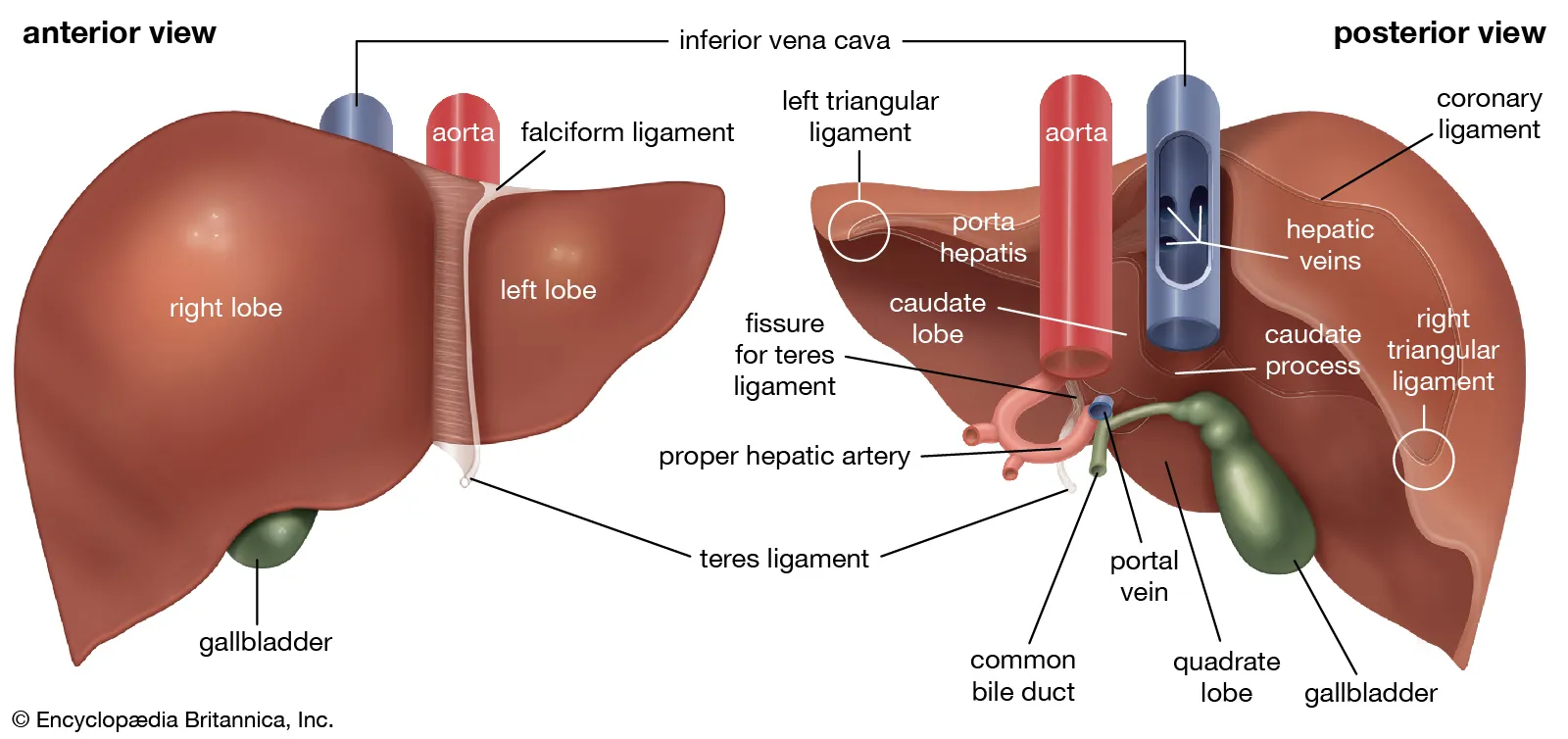
✩ Regulation of carbohydrate metabolism to maintain blood glucose levels
✩ Regulation of fat metabolism including synthesis and β-oxidation
✩ Regulation of protein metabolism, including plasma protein synthesis and detoxification of ammonia through urea formation
✩ Cholesterol synthesis and excretion
✩ Synthesis of specialized molecules such as bile acids and haemin
-
How does the liver receive nutrients and deliver them to the body? (4)
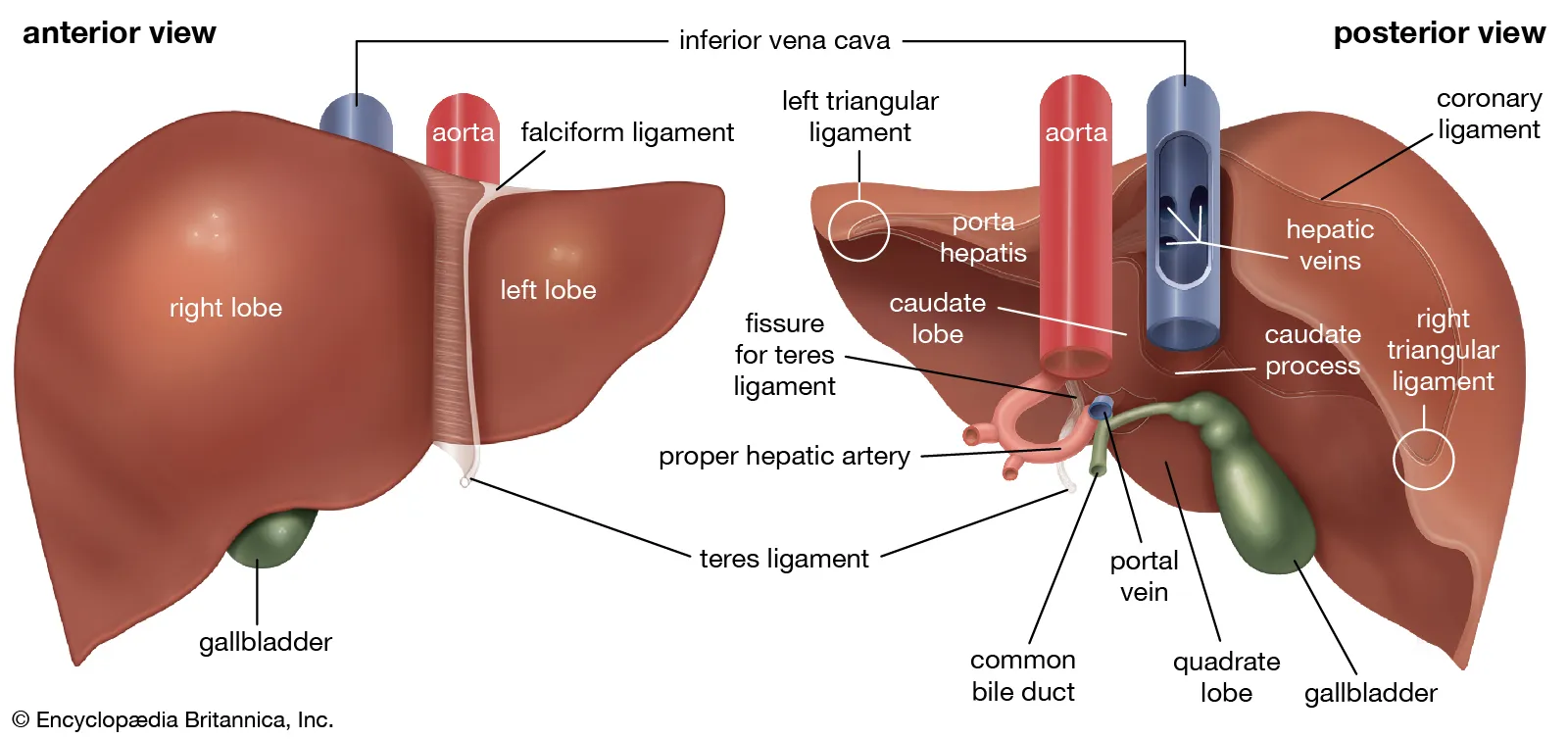
✩ The liver receives blood from the gastrointestinal tract via the portal vein
✩ It delivers major dietary nutrients such as protein and carbohydrates, but not lipids
✩ It also delivers drugs and potential toxins
✩ The liver empties directly into a major vessel entering the heart, ensuring rapid circulation of its products
-
How does the liver influence the digestive process? (2)
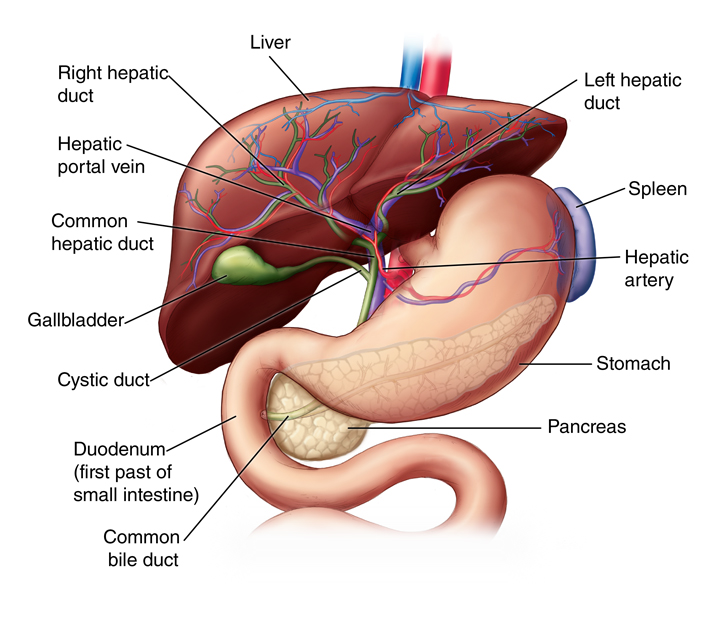
✩ Bile ducts from the liver empty directly into the gut
✩ This allows the liver to rapidly influence the digestive process by aiding in the emulsification and digestion of fats
-
How do we metabolize ethanol? (2)
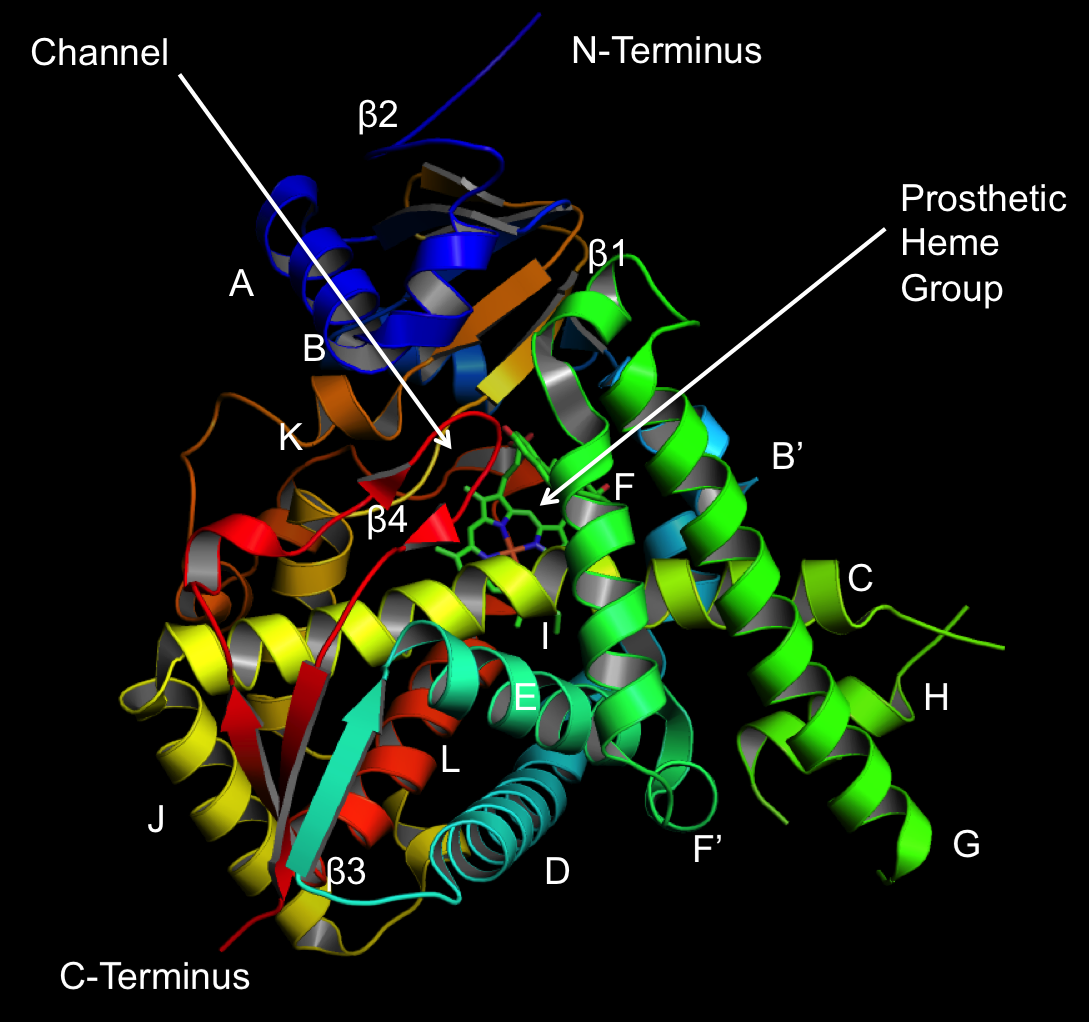
✩ 90% of ethanol is metabolized through oxidation via the activity of alcohol dehydrogenase
✩ 10-20% of ethanol undergoes microsomal oxidation using cytochrome P450
-
What is the approximate rate at which the body metabolizes alcohol? (2)

✩ The body metabolizes approximately 10 grams of alcohol per hour
-
What are the consequences of methanol metabolism? (2)
✩ Methanol is metabolized to formaldehyde, which is highly toxic
✩ This toxicity is associated with conditions such as blindness, paralysis, and loss of consciousness
-
What are the caloric implications of consuming ethanol as spirits? (2)

✩ Ethanol contains 7.1 kcal per gram
✩ If consumed as spirits, ethanol represents 'empty calories'
-
Picture demonstrating the metabolism process of ethanol
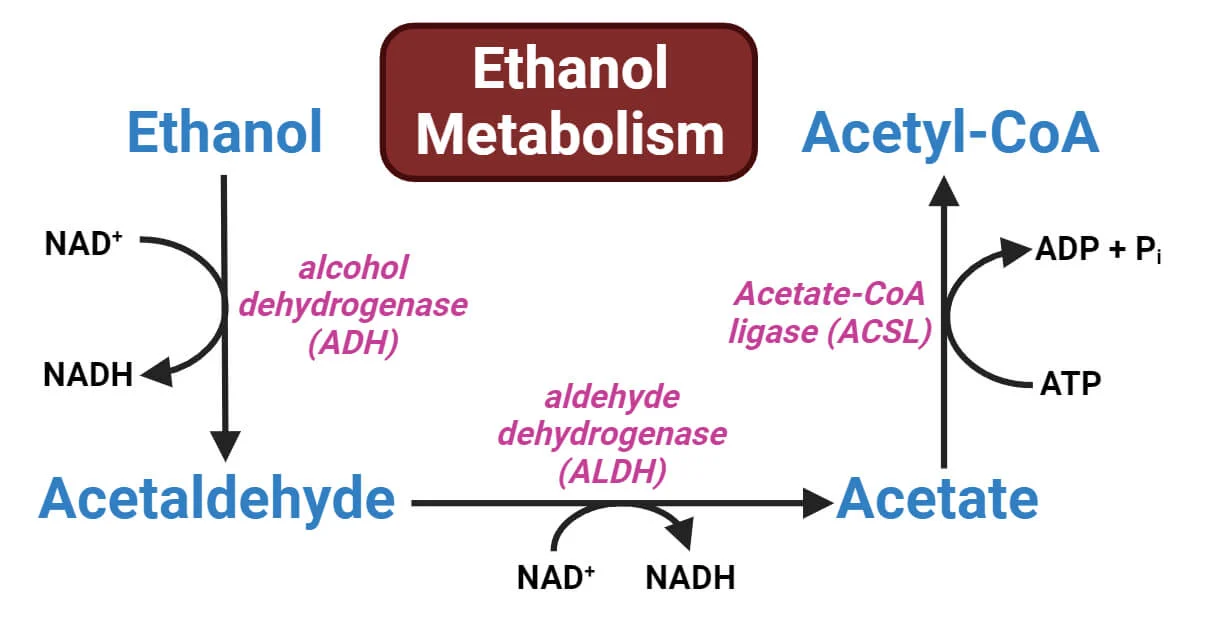
-

What are the consequences of having different isoforms of the ALDH enzyme? (4)
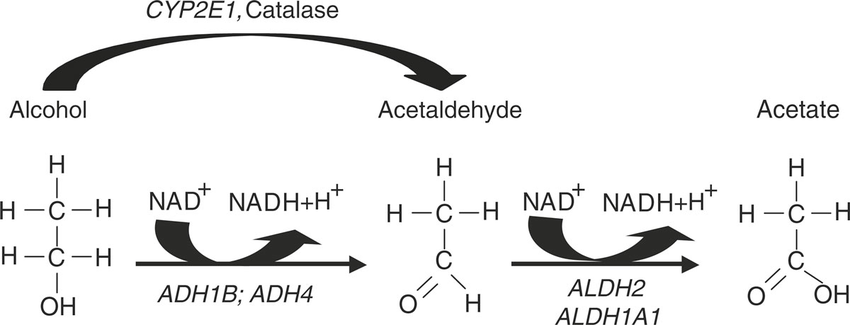
✩ Caucasians have two isoforms: ALDH-1 and ALDH-2
✩ ALDH-2, which is mitochondrial with a low Km, is efficient in metabolizing acetaldehyde
✩ Certain ethnic groups, such as Chinese, Japanese, Indonesians, and Native Americans, predominantly express the less effective ALDH-1
✩ This leads to ethanol intolerance and symptoms like vasodilatation, facial flush, tachycardia, and nausea
-
What is the Microsomal Ethanol-Oxidizing System (MESO)? (3)
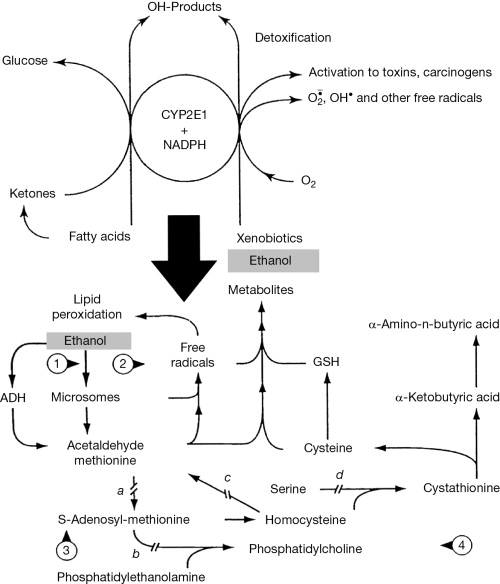
✩ MESO is the second route of ethanol metabolism
✩ It involves the oxidation of ethanol by enzymes from the cytochrome P450 family
✩ This pathway generates acetaldehyde
-
What is a consequence of the Microsomal Ethanol-Oxidizing System (MESO)? (2)
✩ MESO consumes NADPH required for the synthesis of the antioxidant glutathione
✩ This results in increased oxidative stress in the body
-
What does "Km" represent in the context of enzyme kinetics? (3)
✩ Km, or Michaelis constant, is a parameter that indicates the substrate concentration at which an enzyme achieves half of its maximum velocity (Vmax)
✩ In other words, it reflects the affinity of an enzyme for its substrate
✩ A low Km value indicates high affinity between the enzyme and its substrate
-
What are the effects of acetaldehyde accumulation due to excessive ethanol intake? (4)
✩ Acetaldehyde, highly reactive, can accumulate with excessive ethanol intake
✩ It inhibits enzyme function, particularly in the liver
✩ This inhibition can lead to reduced secretion of both serum protein and VLDL (very low-density lipoprotein)
✩ Acetaldehyde accumulation also enhances free-radical production, leading to tissue damage such as inflammation and necrosis
-
What are the three stages of alcohol-related liver damage? (3)
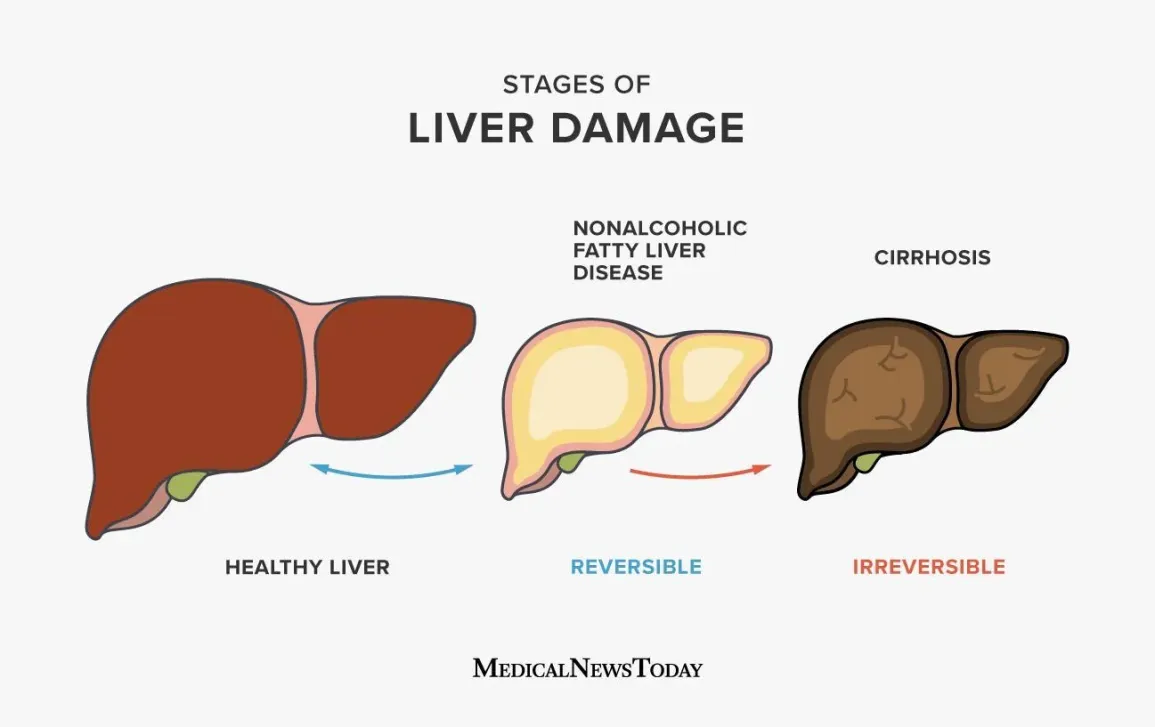
✩ Stage 1: Fatty liver, characterized by the accumulation of fat in liver cells
✩ Stage 2: Alcoholic hepatitis, involving inflammation caused by the death of groups of liver cells
✩ Stage 3: Cirrhosis, which includes fibrosis, scarring, and further cell death
-
What are the consequences of cirrhosis in the liver? (2)
✩ Cirrhosis impairs liver function, leading to the accumulation of ammonia
✩ This accumulation results in neurotoxicity, coma, and ultimately, death
-
What percentage of alcoholics develop cirrhosis, and what proportion of all cases of cirrhosis is due to alcohol? (2)
✩ Cirrhosis arises in 25% of alcoholics
✩ 75% of all cases of cirrhosis are attributable to alcohol consumption
-
What are the consequences of high ethanol metabolism on gluconeogenesis and pyruvate metabolism?
✩ High NADH inhibits gluconeogenesis and stimulates the conversion of pyruvate to lactate, leading to hypoglycaemia and lactic acidosis
-
How does high NADH affect fatty acid metabolism?
✩ High NADH inhibits fatty acid oxidation and stimulates fatty acid synthesis, promoting the formation of triglycerides
-
What inhibitory effects do Acetyl-CoA, NADH, and ATP formed during ethanol metabolism have on glucose metabolism?
✩ Acetyl-CoA, NADH, and ATP inhibit glucose metabolism by inhibiting enzymes such as PFK and pyruvate dehydrogenase
-
How do Acetyl-CoA and NADH impact the TCA cycle?
✩ NADH inhibits the TCA cycle, while Acetyl-CoA increases this inhibition further
-
What are the consequences of Acetyl-CoA formation during ethanol metabolism?
✩ Acetyl-CoA leads to ketone body formation and stimulates fatty acid synthesis
-
What takes precedence over other nutrients during ethanol metabolism?
✩ Oxidation of alcohol takes precedence over other nutrients
-
Is ethanol metabolism regulated by negative feedback?
✩ No, ethanol metabolism is not regulated by negative feedback
-
What are the consequences of ethanol metabolism in terms of the formation of acetyl-CoA, NADH, and ATP?
✩ Large quantities of acetyl-CoA, NADH, and ATP are formed
-
What are xenobiotics, and what are some examples?
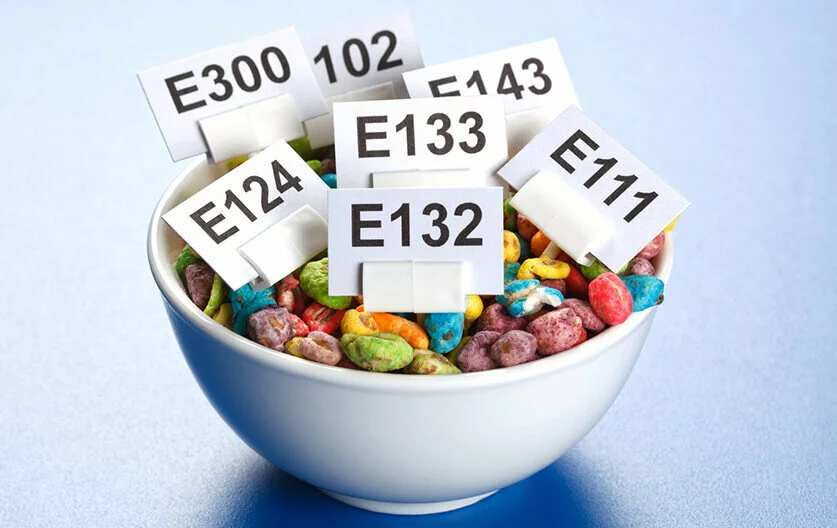
✩ Xenobiotics are compounds with no nutritional value, including plant metabolites, synthetic compounds, food additives, agrochemicals, cosmetics, by-products of cooking, and drugs
-
What is the liver's role in xenobiotic metabolism?
✩ The liver plays a major role in metabolizing xenobiotics, aiming to make them harmless and more readily disposed of by the kidney in urine or the gut in feces
-
What are the three phases of xenobiotic metabolism?
✩ Phase I: Oxidation
✩ Phase II: Conjugation
✩ Phase III: Elimination
-
What is the primary modification that occurs during Phase I oxidation of xenobiotics?
✩ Oxidation is the most common modification, but hydroxylation and reduction also occur
-
What enzymes are primarily responsible for Phase I oxidation?
✩ Cytochrome P450 enzymes, found mainly in the liver and cells of the intestine, are primarily responsible for Phase I oxidation
-
What is the significance of drug metabolism by the liver?
✩ Drug metabolism by the liver is important because it can significantly affect the effectiveness of therapeutic drugs
-
What is the significance of statins in drug metabolism?
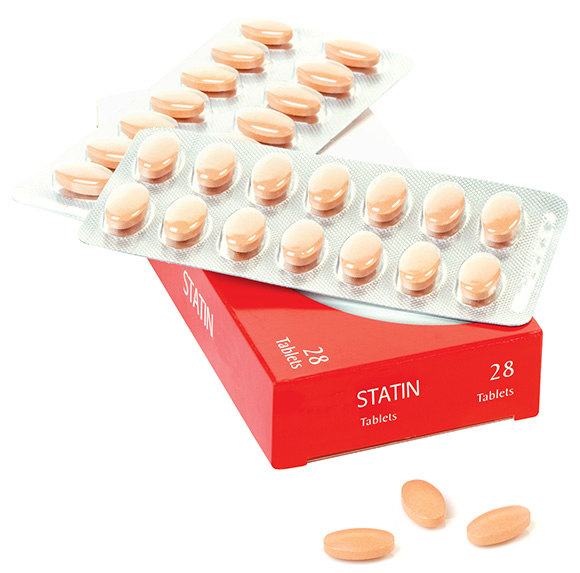
✩ Statins are drugs used to lower cholesterol levels
✩ They are degraded by the enzyme CYP3A4
✩ Interaction with substances like grapefruit juice, which inhibits CYP3A4 activity, can lead to a significant rise in statin levels, potentially causing adverse effects
-
What is Aflatoxin B1, and how is it metabolized?
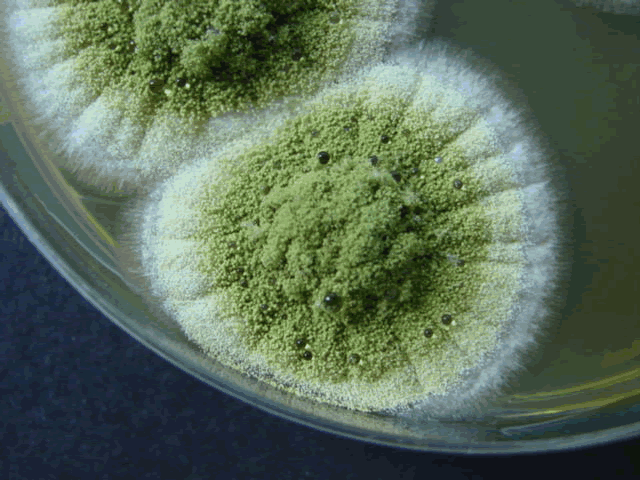
✩ Aflatoxin B1 is a toxin produced by the fungus Aspergillus flavus
✩ It is metabolized by P450 isoenzymes in the liver, leading to the formation of epoxides, which are carcinogenic and can lead to liver cancer
-
Picture demonstrating the metabolism of paracetamol (acetaminophen)
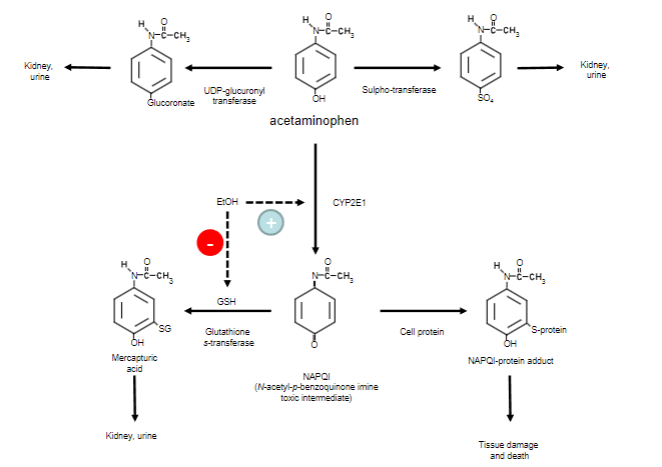
-
How are small water-soluble molecules (<60,000 kDa) removed from the body?
Small water-soluble molecules can be removed by the kidney through filtration
-
What is the fate of modified compounds that are actively transported into bile and then into the intestines? (3)
✩ Digestion
✩ Excretion
✩ Re-absorption via the enterohepatic circulation
-
What does "t½" represent in the context of substance elimination?
"t½" refers to the time required for 50% of a substance to be lost from the body

